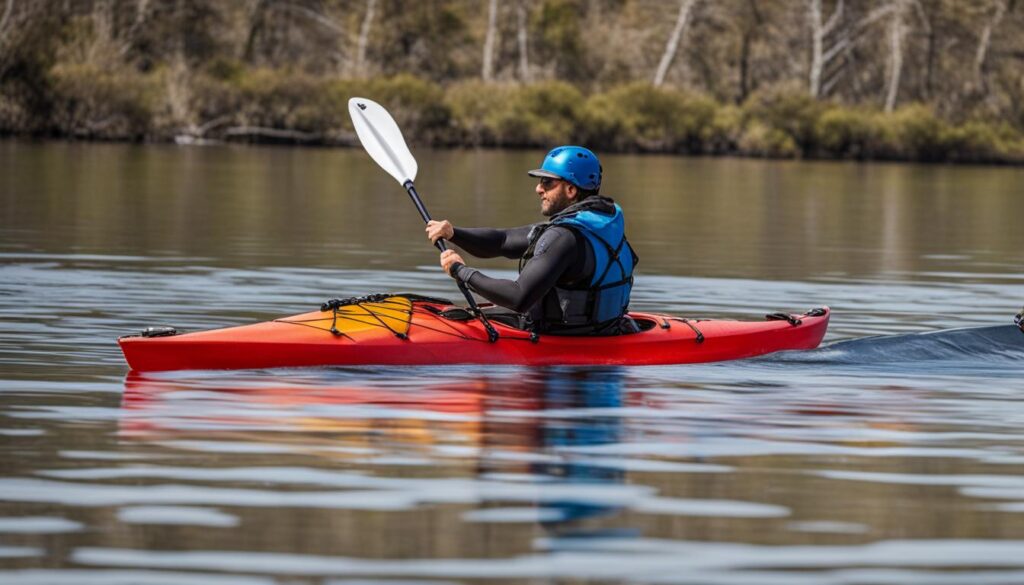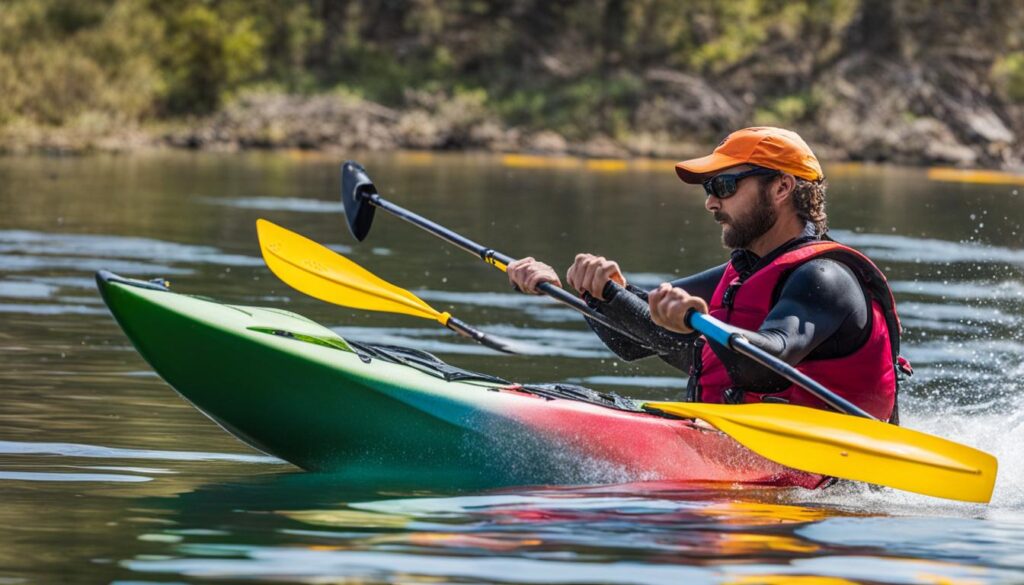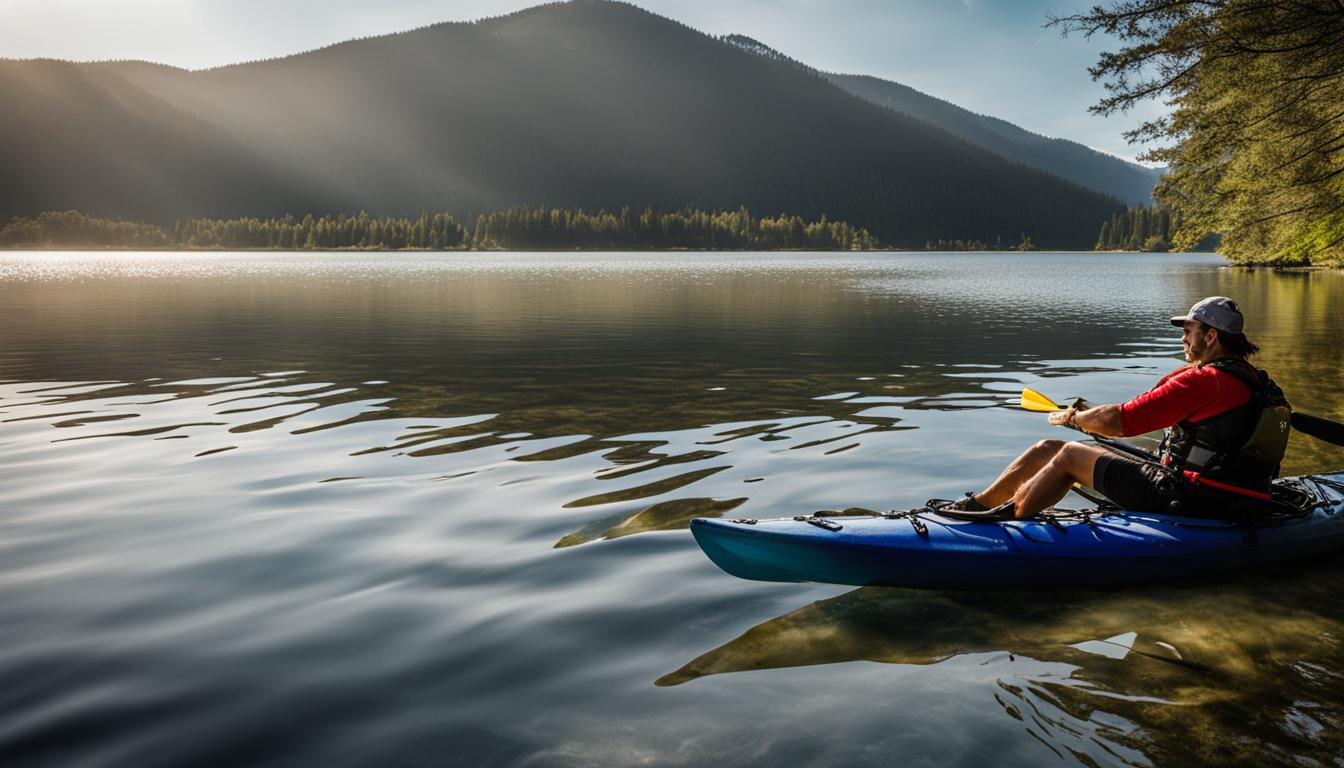In this article, we will guide you through the process of mastering steering and balance in a kayak using foot braces. We will explore the pedal system, rudder control, adjusting to different water conditions, maneuvering techniques, and advanced tips for efficient steering, all of which will help enhance your control and balance while kayaking.
Key Takeaways:
- Foot braces provide enhanced control and balance while kayaking.
- The pedal system allows for steering without paddles.
- Mastering rudder control helps in precise steering.
- Adjusting foot braces for different water conditions enhances balance.
- Maneuvering techniques and proper foot control are crucial for smooth turns.
Understanding the Pedal System
When it comes to mastering kayak foot brace techniques, understanding the pedal system is essential. The pedal system is a key component of a kayak that allows for steering without the need for paddles. Consisting of foot pedals connected to a gear mechanism, it enables you to control the movement of the kayak’s propeller.
By pushing and pulling on the foot pedals, you can adjust the angle of the propeller, thereby changing the direction of the kayak. Familiarizing yourself with the pedal system is crucial for efficient steering and control.
Remember to optimize your foot control by adjusting the foot control system to match your comfort and reach. Experiment with different settings to find the right balance between responsiveness and stability. By using small, precise movements of your feet, you can steer the kayak smoothly and avoid sudden, jerky motions that could compromise stability and control.
Summary
Mastering the pedal system is essential for efficient steering and control in a kayak. By understanding how the foot pedals are connected to the gear mechanism and practicing small, precise movements of your feet, you can enhance your balance, stability, and control while kayaking. Remember to experiment with different settings to find the optimal foot control for your comfort and reach, ensuring a smooth and enjoyable kayaking experience.
| Benefits of Understanding the Pedal System | Techniques for Mastering the Pedal System |
|---|---|
| Enhanced steering and control | Practice small, precise movements of your feet |
| Improved balance and stability | Experiment with different foot control settings |
| Efficient maneuvering through different water conditions | Find the optimal foot control for your comfort and reach |
Mastering the Rudder Control
To effectively control the rudder of your kayak, practice precise movements and maintain a steady balance. The rudder, located at the stern of the kayak, plays a vital role in steering the vessel. Understanding how to manipulate the rudder by using the foot pedals allows for smooth and precise steering. It’s important to make small adjustments and maintain a steady balance to have better control over the kayak’s direction.
When adjusting the rudder control, remember that even small movements can have a significant impact on the kayak’s course. Avoid making sudden or large adjustments, as this can cause the kayak to veer off course or become unstable. Instead, focus on making subtle changes to the rudder angle by using the foot pedals. By practicing and fine-tuning your technique, you’ll be able to achieve precise steering and maintain control of your kayak.
Keep in mind that different water conditions may require adjustments to your rudder control technique. In calm and still waters, you may only need to make gentle movements to maintain a straight course. However, in choppy or windy conditions, you may need to apply more pressure on the foot pedals to counteract the external forces and keep the kayak on track. By adapting your technique to the specific water conditions, you’ll be able to navigate more effectively and maintain your stability.

Practice is key when it comes to mastering the rudder control with foot braces. Start by finding a calm and safe area to practice your steering technique. Experiment with different pedal movements and observe how they affect the kayak’s direction. Gradually increase the difficulty by practicing in more challenging water conditions, such as light currents or gentle waves.
By consistently practicing and refining your rudder control technique with foot braces, you’ll develop a greater sense of control and confidence while kayaking. Remember to always prioritize safety and wear appropriate gear, such as a life jacket. With time and experience, you’ll become a skilled kayaker capable of navigating any water body with ease.
Adjusting to Different Water Conditions
When kayaking, it’s essential to be able to adapt to different water conditions to maintain balance and stability. By using kayak foot braces, you can enhance your control and maneuverability, allowing you to confidently navigate through various challenges. Let’s explore some ways foot braces can help improve your balance while kayaking.
1. Heavy-Duty Adjustable Braces
One effective way to enhance your balance is by using heavy-duty adjustable foot braces. These braces provide stability through their strong and durable construction, allowing you to anchor your feet securely in the kayak. By adjusting the braces to fit your desired position and comfort level, you can maintain a solid and stable connection with the kayak, even in rough waters.
2. Foot Control Step Steering Wheels
Another useful accessory for enhancing balance is the foot control step steering wheel. This innovative device allows you to use your foot to control the kayak’s steering, freeing up your hands for other tasks. With precise foot movements, you can easily navigate through different water conditions while maintaining optimal balance and stability.
3. Kayak Skeg Tracking Fin Integral Fin
In windy or choppy water conditions, maintaining stability can be challenging. A kayak skeg tracking fin integral fin can be a valuable tool to improve your balance. This fin attaches to the kayak’s hull and provides additional stability and tracking, making it easier to steer and maintain your desired course.
By utilizing these various foot braces, you can enhance your balance and stability while kayaking, regardless of the water conditions. It’s important to choose the right braces for your needs and adjust them accordingly to maintain a secure and comfortable connection with the kayak. Remember to always prioritize safety and practice proper technique to ensure a smooth and enjoyable kayaking experience.
| Foot Braces | Benefits |
|---|---|
| Heavy-Duty Adjustable Braces | Provides stability and secure foot placement |
| Foot Control Step Steering Wheels | Allows for hands-free steering and better control |
| Kayak Skeg Tracking Fin Integral Fin | Improves stability and tracking in challenging water conditions |
Maneuvering Techniques for Turning
When it comes to turning your kayak, mastering the right techniques is essential for smooth and precise maneuvers. By utilizing the power of foot braces, you can enhance your control and stability during turns. Two common techniques for turning a kayak are using the kayak rudder and the propeller drive.
Rudder-based Turning Technique
The rudder-based turning technique involves adjusting the position of the rudder using your foot pedals. By pushing one foot forward and pulling the other foot back, you can initiate the turn. The key is to make small adjustments and maintain a steady balance to control the direction of your kayak. Practice this technique in calm waters before attempting it in more challenging conditions.
Propeller Drive Technique
The propeller drive technique utilizes the power of the pedal system to achieve turns. By adjusting the angle of the propeller using your foot pedals, you can create a forward or reverse thrust that steers the kayak. To initiate a turn, push one foot forward while keeping the other foot stationary. Practice this technique to master the coordination and timing required for efficient maneuvering.
Both techniques rely on the proper use of foot braces to maximize control and stability. Remember to use small, precise movements of your feet rather than sudden jerky motions. This will ensure smoother turns and prevent loss of balance. Experiment with different techniques and practice regularly to improve your skills and confidence in maneuvering your kayak.

| Rudder-Based Turning Technique | Propeller Drive Technique | |
|---|---|---|
| Advantages | – Allows for precise control – Can be used in narrow spaces – Effective in calm waters |
– Provides quick response – Suitable for open waters – Offers versatility in steering |
| Disadvantages | – Limited effectiveness in rough waters – May require more effort for wide turns |
– Requires practice to master coordination – Less effective in tight spaces |
| Tips | – Practice maintaining a steady balance – Make minor adjustments for precise turns – Start with small turns before attempting wider angles |
– Coordinate pedal strokes with propeller angle adjustments – Experiment with different pedal positions for varying turning speeds – Practice timing for smooth transitions |
Advanced Tips for Efficient Steering
When it comes to mastering steering and balance in a kayak, understanding the dynamics of foot braces is crucial for better stability and control. By optimizing your foot control and technique, you can enhance your overall kayaking experience. Here are some advanced tips to help you improve your steering:
Adjusting the Foot Control System
To achieve maximum efficiency, it’s essential to adjust the foot control system to match your comfort and reach. Experiment with different settings to find the right balance between responsiveness and stability. By making these adjustments, you’ll ensure that your foot braces are positioned optimally for precise steering.
Emphasizing Small, Precise Movements
When using foot braces, it’s important to remember that small, precise movements of your feet are more effective than sudden, jerky actions. By practicing controlled foot movements, you’ll have better stability and control over the kayak’s direction. Focus on using your foot braces with finesse and avoid excessive force.
Continuously Practicing and Fine-Tuning
Improving your steering skills takes time and practice. Dedicate regular sessions to hone your technique and become more comfortable with using foot braces. By continuously fine-tuning your foot control and experimenting with different strategies, you’ll gradually develop a more intuitive feel for steering and balance in your kayak.
| Advanced Tips for Efficient Steering |
|---|
| Adjust the foot control system to match your comfort and reach |
| Emphasize small, precise movements of your feet |
| Continuously practice and fine-tune your foot control |
Remember, mastering steering and balance using foot braces requires patience and perseverance. The more you practice and experiment with different techniques, the better you’ll become at efficiently controlling your kayak. With these advanced tips, you’ll be well on your way to enjoying a smoother and more stable kayaking experience.
Conclusion
Enhancing balance in kayaks with foot braces is a key aspect of mastering steering and control. By understanding the pedal system and mastering rudder control, you can navigate with confidence and precision. Additionally, adjusting to different water conditions and practicing maneuvering techniques will further enhance your kayaking skills.
When it comes to balance, foot braces play a crucial role. They provide stability and allow for efficient steering by enabling precise movements. By utilizing foot braces and proper foot control, you can enhance your balance, stability, and overall control while kayaking.
Remember to adapt your technique to the specific water conditions you encounter. Different conditions may require adjustments to your foot brace dynamics. Experiment with pedal settings to find the ideal balance between responsiveness and stability. Practice using small, precise movements of your feet for better stability and control, avoiding sudden, jerky motions.
With these techniques and continuous practice, you can enjoy your kayaking adventures with improved steering and balance. So, get out on the water, put your foot braces to good use, and embrace the joy of mastering steering and balance in your kayak!
FAQ
How does the pedal system work in a kayak?
The pedal system in a kayak consists of foot pedals connected to a gear mechanism, which controls the movement of the kayak’s propeller. By pushing and pulling on the foot pedals, you can adjust the angle of the propeller and change the direction of the kayak.
What is the role of the rudder in steering a kayak?
The rudder, located at the stern of the kayak, plays a vital role in steering the vessel. By manipulating the rudder using the foot pedals, you can achieve smooth and precise steering. Maintaining a steady balance and making small adjustments are important for effective control.
How can foot braces enhance balance and stability in rough waters?
By using kayak foot braces, such as heavy-duty adjustable braces and foot control step steering wheels, you can enhance your balance and stability while maneuvering through rough waters. Additionally, a kayak skeg tracking fin integral fin can improve stability and tracking in windy or choppy conditions.
What techniques can be used for turning a kayak?
Two common techniques for turning a kayak are using the kayak rudder and the propeller drive. By adjusting the position of the rudder or the angle of the propeller, you can initiate and control turns. Utilizing foot braces and proper pedal strokes is crucial for executing smooth and precise turns.
How can I optimize my foot control for better steering efficiency?
To optimize your foot control, adjust the foot control system to match your comfort and reach. Experiment with different settings to find the right balance between responsiveness and stability. Use small, precise movements of your feet to steer the kayak, avoiding sudden, jerky movements for better stability and control.
What is involved in mastering steering and balance with kayak foot braces?
Mastering steering and balance in a kayak involves understanding the pedal system, mastering rudder control, adjusting to different water conditions, and practicing maneuvering techniques. By utilizing foot braces and proper foot control, you can enhance your balance, stability, and control while kayaking.





